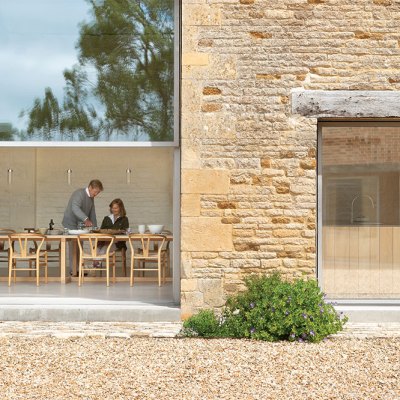Zaha Hadid had the kitchen in her flat in Clerkenwell removed. ‘It was ugly,’ she told the Guardian in 2010. ‘I used to have someone to cook, but he’s gone now. I go out all the time.’ Each to their own, I suppose. For me, living without a kitchen is barely conceivable: it’s one of the few places in which the inbox stops ticking and I can concentrate on nothing more than a chopping board and the cruelty of onions. Many people do live without kitchens, of course, whether by choice or circumstance, but I struggle to think of home without one.
One of the achievements of the Museum of the Home in East London, which reopened in June following a name change (from the Geffrye Museum) and after three years of redevelopment, is to remind us that although one person’s idea of home may overlap with another’s, they will never coincide entirely. We all have a bespoke Venn diagram of home in our heads, which changes as we do: some combination of real and ideal spaces, of memories and expectations, of people and objects. At the revamped museum, the new Home Galleries set out that mutability astutely. These modest spaces – excavated below the terrace of early 18th-century almshouses in which fabrications of period living rooms are still displayed – bring together household objects, historical and contemporary artworks, photographs and oral histories. Their variety and non-linear presentation never allow home to settle as one thing.
But this is not a review of the Museum of the Home. I visit the place in search of kitchens, and with Apollo’s food column to fill. Unlike the new galleries downstairs, the ‘Rooms Through Time’ propose a chronology of domestic life, taking us from a 17th-century hall via Georgian parlours to ‘a loft-style apartment in 1998’. An irony of this display is that it has always squeezed an account of the middle-class home, broadly considered, into buildings that were originally constructed as almshouses: scaling down visions of historical aspiration into spaces that were originally designed to meet a need for housing (the modern rooms displayed in the museum extension from 1998 are more expansive). Spatial constraints mean that there is simply no room to install kitchens. But their absence here bolsters the historical narrative: in prosperous households, the kitchen was a room in which work took place, in which mess became order, a little food factory that was best kept out of sight.
In the loft-style apartment (1998) at the Museum of the Home, London. Photo: Thomas Marks

Only in that open-plan loft apartment does a kitchen dare to show itself, no longer tucked away from view but reimagined as a lifestyle feature, even a cosmopolitan boast. ‘It is 7pm and Matthew and his partner Ben are preparing food for some friends,’ reads an accompanying text that, as with every staged room here, projects imagined occupants into the display. Nigella Lawson’s How to Eat is propped open on a metal stand; spears of asparagus loiter in a colander; and a J-cloth swaddles the mixer tap like a horse rug protecting a thoroughbred.
But there are other kitchens in the revamped museum. ‘Table Talk’, the final room in the new enfilade of galleries downstairs, asks the visitor to ‘take a seat at our kitchen table’ and respond – through talking or writing – to questions that the museum has posed about the home (when I visit these are: ‘How has lockdown changed your home life?’ and ‘Where do you store ketchup?’). It’s a neat encapsulation of how the kitchen has become a meeting place in many modern homes, a room in which talk is fond or frank, in which plans are hatched and disputes are resolved. The space is decorated with a mural of the stylised outlines of kitchen cabinets and appliances, set against a ham-pink background: the effect is like stepping into a Patrick Caulfield painting.
Upstairs, in a room that used to be the staff mess, is a new kitchen that could be mistaken for one of the ‘Rooms Through Time’ but has a different purpose. The Plain English Kitchen will be used by museum employees and as a space for public workshops and events, as well as for preparing meals for private functions in the panelled room it leads on to. This has been donated by a luxury kitchen brand, Plain English, and has a vaguely Georgian air, with its chequered floor imitating flagstones and walls painted ‘stone blue’ (‘named after the indigo pigment which was often imported in lumps in the 18th century,’ as the Farrow & Ball website tells me). It will weather with use, no doubt, but in its virginal condition on the museum’s press preview day it looks like nothing more than a Notting Hill show kitchen. And so much the better: a museum that takes domesticity as its focus ought to make us think about how home is forever being marketed to us.
The Plain English Kitchen at the Museum of the Home, London

To finish, the best kitchen of the lot: the professional galley in Molly’s Cafe, the new restaurant attached to the museum, which has taken over the Victorian pub on site that was once threatened with demolition. It’s run by the restaurateurs who also have the Anchor & Hope near Waterloo and the Magdalen Arms in Oxford, among other venues, and have long had a reputation for good cooking. When I visit, fresh from the museum itself, domestic interiors are on my mind: smoked herring on lentil ragu has the autumnal colours of soft furnishings from the 1970s; panelle of fried polenta look like cushions made for a doll’s house. Both are delicious. The menu changes daily. The food is reasonably priced. Call it a home from home, if you will – but perhaps only if you want to rip out your kitchen.
This Apollo food column was first published in the July/August 2021 issue of the magazine. Preview and subscribe here.


